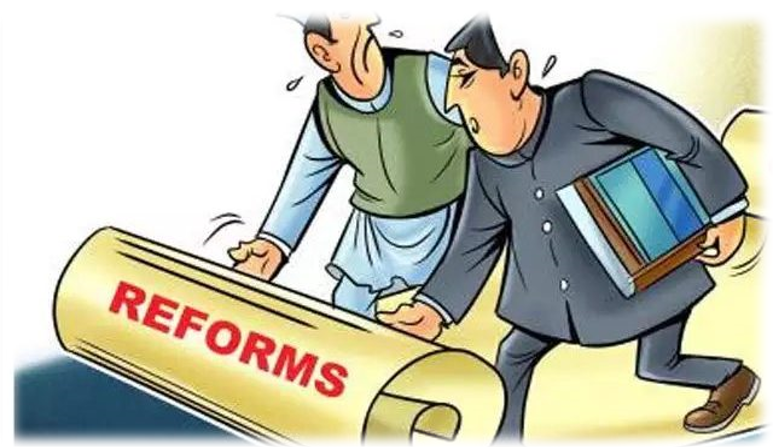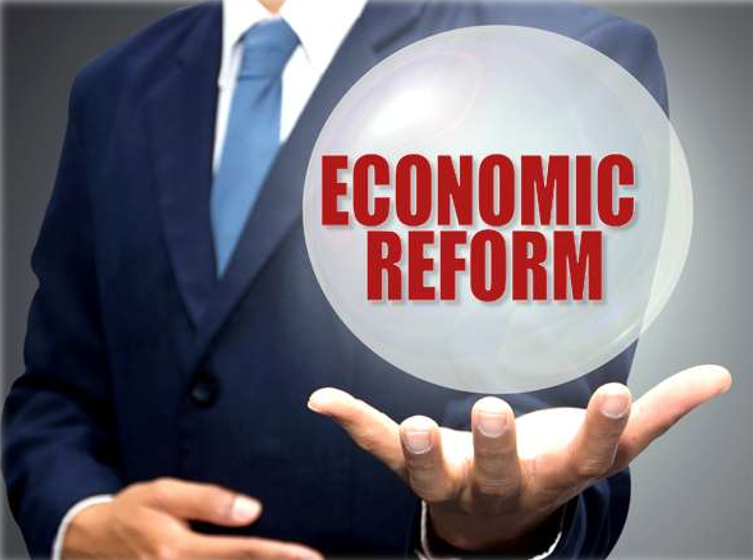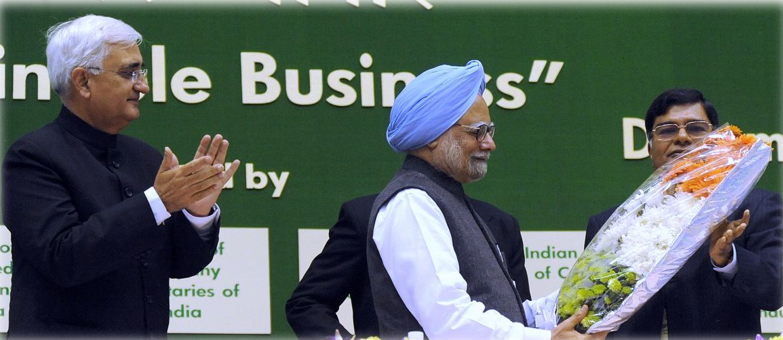
Introduction
Economic reforms are a set of fundamental adjustments that began in 1991 with the goal of liberalization of the economy and speeding up its development rate. In 1991, the Narasimha Rao government began economic policies in order to restore internal and external confidence in the Indian economy.
The changes aimed to increase the private sector’s participation in the Indian economy’s growth strategy. Technological advancements, industrial licensing, the lifting of constraints on the private sector, foreign investments, and foreign commerce were all recommended as policy improvements. Economic liberalization, Privatisation, and Globalisation (often referred to as LPG) are three key characteristics of economic reforms.
Why Were Economic Reforms Introduced In India?

- Economic reforms were introduced in India because of the following reasons:-
The Public Sector's Poor Performance
During the period 1951–1990, the public sector was given a significant role in development policies.
The majority of state enterprises, on the other hand, performed poorly.
They were losing a lot of money due to ineffective management.
Imports Outnumber Exports Or The BOP Is Unfavourable.
Imports increased at a rapid pace, far outpacing export growth.
Even after establishing high taxes and quotas, the government was unable to limit imports.
Exports, on the other hand, were very low due to our items’ inferior quality and expensive pricing when compared to international goods.
Reserves Of Foreign Currency Had Decreased.
Foreign exchange (foreign currency) reserves, which the government usually keeps on hand to import gasoline and other essentials, have plummeted to levels that are insufficient to last even a fortnight.
The government was unable to repay its foreign borrowings.
Government Debts Are Enormous.
The government’s spending on numerous development projects exceeded its tax collection.
As a result, the government borrowed money from banks, public and international financial institutions such as the International Monetary Fund (IMF), and other sources.
Inflationary Strains
The general price level of necessary products in the economy has been steadily rising.
A fresh set of policies was needed to keep inflation under control.
Terms And Conditions Of The World Bank And The International Monetary Fund
- India received $7 billion in financial assistance from the World Bank and the International Monetary Fund in exchange for announcing its New Economic Policy.
Pre-Liberalisation Period (1947–1991)

Following independence, Indian economic policy was affected by the colonial experiences, which Indian leaders saw as exploitative, as well as their exposure to ideology and the Soviet Union’s economic growth. Domestic policy leaned toward protectionism, with a focus on import substitution, industrialization, economic adventurism, a substantial public sector, company regulation, and central planning, whereas trade and foreign investment policies were generally liberal. India’s five-year plans mirrored Soviet-style central planning. In the mid-1950s, a number of industries, including steel, mining, machine tools, water, telecoms, banking, and electrical plants, were essentially nationalized.
During the early years of India’s existence, Jawaharlal Nehru, the countries first prime minister, and statistician Prasanta Chandra Mahalanobis devised and managed economic strategy. They hoped that their plan, which included rapid expansion of heavy industry by both the public and private sectors and was based on direct and indirect state intervention rather than the more extreme Soviet-style central command system, would provide positive results.
Milton Friedman, an economist, criticized the policy of concentrating on capital- and technology-intensive heavy industry while subsidizing manual, low-skill cottage businesses, believing it would squander capital and labor while slowing the development of small manufacturers. Because of the unfavorable contrast with growth rates in other Asian countries, particularly the East Asian Tigers, the Indian economy’s pace of growth in the first three decades after independence was mockingly referred to as the Hindu rate of growth.
Reforms Before 1991
India’s reform plan, which began in July 1991, was a blend of macroeconomic stabilization and structural change. It was guided by both short- and long-term goals. In the short term, stabilization was required to restore the balance of payments equilibrium and contain inflation. Simultaneously, modifying the structure of institutions through reforms was equally crucial from a long-term perspective.
The new government moved quickly to put in place a macroeconomic stabilization policy based on budgetary adjustment. Aside from that, fundamental reforms in commerce, industry, and the public sector have been implemented.
Impact And Objectives Of The Reforms
The reforms’ goals, according to the Ministry of Finance’s Discussion Paper on Economic Reforms published in July 1993, were:
“…to improve the quality of life for the people of India in a swift and sustainable manner.” The rapid development of earnings and productive employment is key to this goal… The only long-term answer to poverty is continued income and employment development… Such expansion necessitates investment in agriculture, roads, irrigation, industry, power, and, most importantly, people. And this investment has to pay off. Continued advances in the productivity of our capital, land, and labor are required for successful and long-term growth. East Asian countries have changed dramatically in just a decade. Today, China, Indonesia, Korea, Thailand, and Malaysia have far higher living levels than we do… We must strive for what they have accomplished.”
The Reforms Of 1991: Major Steps

- The following are the primary policy actions taken by the government to solve the balance of payments problem and structural rigidities:
Fiscal Reforms:-
Restoring fiscal discipline was a critical component of the stabilization process. According to the data, the budget deficit in 1990-91 was as high as 8.4% of GDP. The 1991-92 budgets take a bold move toward rectifying the fiscal imbalance. It called for a nearly two-percentage-point reduction in the fiscal deficit from 8.4% of GDP in 1990-91 to 6.5 percent in 1991-92.The budget aimed to reduce government spending while increasing revenues, as well as reversing the downward trend in the share of direct taxes in overall tax receipts and restraining extravagant spending. Reduced fertilizer subsidies, abolition of sugar subsidies, disinvestment of a portion of the government’s equity holdings in select public sector undertakings, and acceptance of major recommendations of the Tax Reforms Committee headed by Raja Chelliah were some of the major policy initiatives introduced in the budget for the year 1991-92 to correct the fiscal imbalance. These suggestions attempted to increase revenue by improving compliance with income tax, excise, and customs taxes, as well as making the tax structure more stable and transparent.
Monetary And Financial Sector Reforms:-
Monetary reforms aimed at removing interest rate distortions and reorganizing the lending rate structure. The new policy attempted to improve the financial sector in a variety of ways. The following are some of the actions taken:
Reserve Requirements:-
- In accordance with the recommendations of the Narasimham Committee Report, 1991, the statutory liquidity ratio (SLR) and the cash reserve ratio (CRR) were reduced. SLR and CRR were extremely high in mid-1991. Within three years, the SLR was projected to be reduced from 38.5 percent to 25 percent. Similarly, it was recommended that the CRR be reduced to 10% (from the previous 25%) over a four-year period.
Interest Rate Liberalization:-
Previously, the RBI controlled the rates payable on various maturities of deposits, as well as the rates that might be charged for bank loans, which varied according to on the sector of use and the loan size. Interest rates on time deposits were deregulated through a series of steps, beginning with longer-term deposits and gradually extending to deposits with shorter maturities.
Increased competition among public, private, and international banks, as well as the removal of administrative barriers
Bank branch licensing policy should be liberalized in order to rationalize the existing branch network.
Banks were given the authority to move branches and open specialized branches.
Capital Market Reforms:-
- The Narasimham Committee’s recommendations were implemented in order to reform capital markets, with the goal of removing direct government control and replacing it with a regulatory framework based on transparency and disclosure overseen by an independent regulator. The Securities and Exchange Board of India (SEBI), which was established in 1988, received statutory recognition in 1992 as a result of the Narasimham Committee’s recommendations. SEBI’s mandate is to create an environment that facilitates the mobilization of enough resources and their effective distribution through the securities market.

Reforms in Industrial Policy:-
A series of adjustments in the Industrial Policy was implemented to cement the gains made during the 1980s and to offer stronger competitive stimulation to the domestic industry. On July 24, 1991, the government launched a New Industrial Policy. The 1991 New Industrial Policy aims to significantly de-regulate industry in order to support the development of a more efficient and competitive industrial sector. The following were the fundamental features of industrial policy reforms:
With the exception of 18 industries, the industrial license was discontinued for all projects. This effectively removed 80% of the industry from the licensing structure.
The Monopolies and Restrictive Trade Practices (MRTP) Act was repealed in order to remove the requirement for major enterprises to obtain prior clearance for capacity development or diversification.
The areas reserved for the public sector were reduced, and the private sector was allowed to participate more fully in core and basic industries. The number of reserved spaces was lowered from 17 to 8 under the new policy. These eight are mostly concerned with strategic and security issues. (Examples include railways, atomic energy, and so on.)
Government holdings of equity share capital in public sector businesses were encouraged to be disinvested under the policy.
Through an MOU (Memorandum of Understanding) between the firm and the concerned Ministry, which established targets that the enterprise had to meet, the public sector units were given greater autonomy and professional management that could enable them to generate respectable profits.
Trade Policy Reforms: The fundamental goal of trade policy reforms was to increase openness. As a result, the policy package was mostly focused on the outside world. In trade policy, new measures were launched to establish an atmosphere that would encourage exports while also lessening the degree of regulation and licensing control on international trade.
The following are the major characteristics of the new trade policy as it has evolved since 1991:
Freer imports and exports: Prior to 1991, India’s imports were regulated by a positive list of items that may be freely imported. Imports have been monitored by a limited negative list since 1992. For example, the 1 April 1992 trade policy liberalized imports of practically all intermediate and capital items. Only 71 goods were still prohibited. Abolition of quantitative constraints and rationalization of tariff structure: The Chelliah Committee’s report recommended a significant reduction in import taxes. It had forecasted a peak rate of 50%. The 1991-92 budgets cut the peak rate of import tax from more than 300 percent to 150 percent as the first step toward a steady reduction in tariffs. In subsequent budgets, the process of decreasing customs tariffs was continued.
Trading Houses: Under the 1991 policy, export houses and trading houses were allowed to import a wide variety of goods. For the objective of encouraging exports, the government also allowed the establishment of trading houses with 51 percent foreign equity. Export houses and trading houses, for example, were given the benefit of self-certification under the advance licensing system, which allows duty-free imports for exports, under the 1992-97 trade strategy.
Promoting Foreign Investment: During the post-reform period, the government adopted a number of steps to encourage foreign investment in India. The following are some of the most crucial indicators:
The government established in 1991 a list of high-tech and high-investment priority industries for which automatic authorization for foreign direct investment (FDI) up to 51 percent foreign equity was granted. For several of these industries, the cap was lifted to 74 percent and then to 100 percent. Furthermore, over time, several new industries have been added to the list.
The Foreign Investment Promotion Board (FIPB) was established to engage with international companies and approve direct foreign investment in certain sectors.
From time to time, steps were taken to encourage foreign institutional investment (FII) in India.
Rationalization of Exchange Rate Policy: The depreciation of the rupee was one of the most important steps done to improve the balance of payments situation. The rupee was devalued by roughly 20% in the first week of July 1991. The goal was to close the gap between real and nominal exchange rates that had opened up as a result of rising inflation, making exports more competitive. The formal sector was the focus of the 1991 economic changes, and as a result, we have witnessed a considerable rise in those areas that were liberalised. Deregulation and subsequent changes have benefitted industries such as telecommunications and civil aviation. Liberalization and economic reforms, on the other hand, have a long way to go, particularly for the informal sector, which includes the urban poor who work as street vendors or rickshaw pullers, the agricultural sector, MSMEs, and tribal’s. The lack of reform in these sectors has resulted in slow development and stagnation, underscoring the importance of the 1991 reforms in transforming India’s economy into what it is now.
Conclusion

Economic liberalization in India. Economic liberalization in India refers to the economic liberalization, initiated in 1991, of the country’s economic policies, with the goal of making the economy more market and service-oriented and expanding the role of private and foreign investment. Economic reforms could be a multi-faceted package of policies (including liberalization, globalization, and privatization) and a program for rapid growth, production efficiency, and the creation of a competitive environment in the future. The Indian government implemented economic reforms in 1991.
Top 13 Interesting Facts About 1991 Economics Reforms
Due to an unfavorable balance of payments, a repayment issue arose.
Exchange reserve declines as imports outpace exports.
Price increases are having a negative impact on investment.
Government spending has outpaced receipts, resulting in a growing fiscal deficit.
Using Disinvestment to Raise Funds
Improving the government’s economic situation.
Increase in the foreign investment equity limit.
Increase in exports.
Increasing the amount of healthy competition in a market
Creating an enabling environment for foreign direct investment
The Gulf situation has pushed up oil prices, which has harmed BOP.
The fall of the Soviet Union.
Deficit financing at a high rate.
Some FAQs Or Also Ask Question
What are the reasons for economic reforms in 1991?
The year 1991 saw India face an unprecedented financial crisis. The crisis was triggered by a major Balance of Payments situation. The crisis was converted into a golden opportunity to reform the country’s economic situation and make-up and introduce fundamental changes in economic policy.The government brought in structural reforms and stabilization policies. While the former was aimed at removing the rigidities in the various sectors of the Indian economy, the latter was aimed at correcting the weaknesses that had emerged on the fiscal and BoP fronts. India’s Prime Minister, when the New Economic Policy (NEP) was introduced was P V Narasimha Rao and the Finance Minister was Dr. Manmohan Singh.
Who announced the economic reforms in 1991?
P.V Narasimha Rao was the Prime Minister of India when the New Economic Policy of 1991 was introduced. Dr. Manmohan Singh was the Finance Minister.
What are the major changes and reforms in the Indian economy since 1991?
Adverse balance of payments resulted in repayment crisis, Fall in exchange reserve: as imports grew faster than exports, The rise in prices, which has a negative impact on Investment., Mounting fiscal deficit as govt. expenditure grew faster than revenue, The Gulf crisis increases petroleum prices which negatively affected BOP., The collapse of the soviet block., High rate of deficit financing
Who is called the father of Indian economic reforms?
Manmohan Singh
Why did India open its economy in 1991?
The 1991 Indian economic crisis was an economic crisis in India resulting from a balance of payments deficit due to excess reliance on imports and other external factors. India’s economic problems started worsening in 1985 as imports swelled, leaving the country in a twin deficit: the Indian trade balance was in deficit at a time when the government was running on a huge fiscal deficit. The collapse of the Soviet Bloc, with which India had rupee exchange in trade, also caused problems. By the end of 1990, in the run-up to the Gulf War, the dire situation meant that the Indian foreign exchange reserves could have barely financed three weeks’ worth of imports. Meanwhile, the government came close to defaulting on its own financial obligations. By July that year, the low reserves had led to a sharp depreciation/devaluation of the rupee, which in turn exacerbated the twin deficit problem. The Chandrasekhar government could not pass the budget in February 1991 after Moody downgraded India’s bond ratings. The ratings further deteriorated due to the unsuccessful passage of the budget. This made it impossible for the country to seek short term loans and exacerbated the existing economic crisis. The World Bank and IMF also stopped their assistance, leaving the government with no option except to mortgage the country’s gold to avoid defaulting on payments. In an attempt to seek an economic bailout from the IMF, the Indian government airlifted its national gold reserves The crisis, in turn, paved the way for the liberalization of the Indian economy, since one of the conditions stipulated in the World Bank and IMF loan (structural reform), required India to open itself up to participation from foreign entities in its industries, including its state-owned enterprises. The liberalization of Indian economy resulted in a large increase in inequality with income share of Top 10% of the population increasing from 35% in 1991 to 57.1% in 2014. Likewise, the income share of Bottom 50% decreased from 20.1% in 1991 to 13.1% in 2014.







